#union density
Text
Tech workers and gig workers need each other

Catch me in Miami! I'll be at Books and Books in Coral Gables on Jan 22 at 8PM.

We're living in the enshittocene, in which the forces of enshittification are turning everything from our cars to our streaming services to our dishwashers into thoroughly enshittifified piles of shit. Call it the Great Enshittening:
https://pluralistic.net/2023/11/09/lead-me-not-into-temptation/#chamberlain
How did we arrive at this juncture? Is it the end of the zero rate interest policy? Was it that the companies that formerly made useful things that we valued underwent a change in leadership that drove them to make things worse? Is Mercury in retrograde?
None of the above. There have been many junctures in which investors demanded higher returns from firms but were not able to force them to dramatically worsen their products. Moreover, the leaders now presiding over the rapid unscheduled disassembly of once-useful products are the same people who oversaw their golden age. As to Mercury? Well, I'm a Cancer, and as everyone knows, Cancers don't believe in astrology.
The Great Enshittening isn't precipitated by a change in how greedy and callous corporate leaders are. Rather, the change is in what those greedy, callous corporate leaders can get away with.
Capitalists hate capitalism. For a corporate executive, the fact that you have to make good things, please your customers, pay your workers, and beat the competition are all bugs, not features. The best business is one in which people simply pay you money without your having to do anything or worry that someday they'll stop. UBI for the investor class, in other words.
Douglas Rushkoff calls this "going meta." Don't sell things, provide a platform where people sell things. Don't provide a platform, invest in the platform. Don't invest in the platform, buy options on the platform. Don't buy options, buy derivatives of options.
A more precise analysis comes from economist Yanis Varoufakis, who calls this technofeudalism. Varoufakis draws our attention to the distinction between profits and rents. Profit is the income a capitalist receives from mobilizing workers to do something productive and then skimming off the surplus created by their labor.
By contrast, rent is income a feudalist derives from simply owning something that a capitalist or a worker needs in order to be productive. The entrepreneur who opens a coffee shop earns profits by creaming off the surplus value created by the baristas. The rentier who owns the building the coffee shop rents gets money simply for owning the building.
The coffee shop owner can never rest. At any moment, another coffee shop can open down the street and lure away their customers and their baristas. When that happens, the coffee shop goes bust and the owner is ruined. But not the landlord! After the coffee shop goes bust, the landlord's asset is more valuable – an empty storefront just down the street from the hottest coffee shop in town.
Capitalists hate capitalism. Faced with a choice of retaining their workers by paying them a fair wage and treating them well, or by saddling them with noncompetes that make it impossible to work for anyone else in the same field, and obligations to repay tens of thousands of dollars for "training" if they quit, bosses will take the latter every time. Go meta, baby.
Same for competition. Faced with the choice of competing to win the most customers with the best products, or merging so that customers have nowhere else to go, even the bitterest of rivals find it remarkably easy to intermarry until our corporations landscape is so interbred the dominant firms all have Habsburg jaws. Think: Facebook-Instagram. Disney-Fox. Microsoft-Activision:
https://locusmag.com/2021/07/cory-doctorow-tech-monopolies-and-the-insufficient-necessity-of-interoperability/
Enshittification has complex underlying dynamics and a reliable procession of stages, but the effect is quite straightforward: things are enshittified when they become worse for the people who use them and the suppliers who makes them, but nevertheless, the users keep using and the suppliers keep supplying.
There are four forces that stand in the way of enshittification, and as each of these forces grows weaker, enshittification proliferates.
The first and most important of these constraints is competition. Capitalists claim to love competition because it keeps firms sharp: they must constantly find ways to improve products and cut costs or be swept away by a superior alternative. There's a degree of truth here, but that's not the whole story.
For one thing, competition can "improve" things that we would rather see abolished. Critics of the GDPR, the EU's landmark privacy law, often point to the devastation that enforcing privacy law had on the European ad-tech industry, driving small firms out of business. But these firms were the most egregious privacy offenders, because they had the least to lose, lacking the dominant position of US-based Big Tech surveillance companies.
Having the least to lose, they were the most reckless with their privacy invasions – but they were also the least equipped to pay expensive enablers from giant corporate law firms to hold off European enforcers, and so they were obliterated. The resulting lack of competition is fine, as far as privacy goes: we don't want competition in the field of "who is most efficient at violating our human rights":
https://www.eff.org/deeplinks/2021/04/fighting-floc-and-fighting-monopoly-are-fully-compatible
But there's another benefit to competition: disorganization. A sector with hundreds of medium-sized, competing companies is a squabbling mob, incapable of agreeing on the site for an annual meeting. An industry dominated by a handful of firms is a cartel, handily capable of presenting a unified front to policy makers, and their commercial coziness provides them with vast war-chests they can use to suborn governments and capture their regulators:
https://pluralistic.net/2022/06/05/regulatory-capture/
Competition is the first constraint. When there's competition, corporate managers fear that you will respond to enshittification by defecting to a rival, costing them money. They don't care about your satisfaction, but they do care about your money, and competition hitches their ability to satisfy you to their ability to get paid by you.
Competition has been circling the drain for 40 years, as the "consumer welfare" theory of antitrust, hatched by Reagan's court sorcerers at the University of Chicago School of Economics, took hold. This theory insists that monopolies are evidence of "efficiency" – if everyone shops at one store, that's evidence that it's the best store, not evidence that they're cheating.
For 40 years, we've allowed companies to violate antitrust law by merging with major competitors, acquiring fledgling rivals, and using investor cash to sell below cost so that no one else can enter the market. This has produced the inbred industrial hulks of today, with five or fewer firms dominating everything from eyeglasses to banking, sea freight to professional wrestling:
https://www.openmarketsinstitute.org/learn/monopoly-by-the-numbers
The endless and continuous weakening of competition has emboldened corporate enshittifiers, who operate on the logic of Lily Tomlin in her role as an AT&T spokeswoman: "We don't care. We don't have to. We're the phone company":
https://vimeo.com/355556831
But the drawdown of competition has also enabled regulatory capture, by converting cutthroat adversaries to kissing cousins. These companies have convinced their regulators not to enforce privacy, consumer protection or labor laws, provided that the gross violations of these laws are accomplished via apps.
This is where tech exceptionalism is warranted: while the bosses that run these companies aren't any nobler – or more wicked – than the Robber Barons of yore, they are equipped with a digital back-end for their businesses that let them change the rules of the game from moment to moment.
Think of labor law: as Veena Dubal writes, gig-work companies practice algorithmic wage discrimination, turning your paycheck into a slot machine that pays out more when you are more selective about which jobs you take, and which then docks your pay by tiny increments as you become less discriminating about answering the app's call:
https://pluralistic.net/2023/04/12/algorithmic-wage-discrimination/#fishers-of-men
This is a plain violation of labor law, but the fiction that gig workers are contractors, combined with the opacity and speed of the wage discrimination back-end, lets the companies get away with it.
But the monsters who hatched this scam are no worse than their forebears, nor are they any smarter. Any black-hearted coal-boss memorialized in a Tennessee Ernie Ford song would have gladly practiced algorithmic wage discrimination – but there just weren't enough green-eyeshade accountants in the back office to change the payout from second to second.
I call this "twiddling" – turning the knobs on the back end to continuously adjust the business logic that the firm operates on:
https://pluralistic.net/2023/02/19/twiddler/
Twiddling is everywhere, and it is only possible because "it's not a crime if we use an app" has been accepted by (captured) regulators. Think of Amazon's "pricing paradox," where deceptive search results – which Amazon makes $38b/year on – allow the company to offer lower prices, but charge higher ones:
https://pluralistic.net/2023/11/06/attention-rents/#consumer-welfare-queens
The first constraint on enshittification is competition – the fear that you'll lose money when a disgusted customer take their business elsewhere. The second constraint is regulation – the fear that a regulator's punishment will eat up all the expected gains from an enshittificatory move, or even exceed those gains, leading to a net loss.
But the less competition there is in a sector, the easier it is for the remaining companies to capture their regulators. Say goodbye to that second constraint.
But there's another constraint – another one that's unique to technology, and genuinely exceptional. That's self-help. Digital technology is infinitely flexible, which is why managers can twiddle the business logic and change the rules on a dime.
But it's a double-edged sword. Users can twiddle back. The universal nature of digital products means it's always technically possible to disenshittify the enshittified products in your world. Mercedes wants to charge you rent on your accelerator pedal via a monthly subscription? Just mod the car by toggling the "subscription paid" bit and get the accelerator for free:
https://pluralistic.net/2023/07/24/rent-to-pwn/#kitt-is-a-demon
HP tricks you into installing a "security update" that sneakily disables your printer's ability to recognize and use third-party ink? Just roll back the operating system and you won't be forced to spend $10,000/gallon to print out your boarding passes and shopping lists:
https://www.eff.org/deeplinks/2020/11/ink-stained-wretches-battle-soul-digital-freedom-taking-place-inside-your-printer
Self-help – AKA "adversarial interoperability" – isn't just a way to override the greedy choices of corporate sadists. It's a way to hold those sadists in check. It's a constraint.
Imagine a boardroom where someone says, "I calculate that if we make our ads 25% more invasive and obnoxious, we can eke out 2% more in ad-revenue." If you think of a business as a transhuman colony organism that exists to maximize shareholder value, this is a no-brainer.
But now consider the rejoinder: "If we make our ads 25% more obnoxious, then 50% of our users will be motivated to type, 'how do I block ads?' into a search engine. When that happens, we don't merely lose out on the expected 2% of additional revenue – our income from those users falls to zero, forever."
Self-help is the third constraint on enshittification. But when competition fails, and regulatory capture ensues, companies don't just gain the ability to flout the law – they get to wield the law, too.
Tech firms have cultivated a thicket of laws, rules and regulations that make self-help measures very illegal. This thicket is better known as "IP," a term that is best understood as meaning "any policy that lets me control the conduct of my competitors, my customers and my critics":
https://locusmag.com/2020/09/cory-doctorow-ip/
To put an ad-blocker in an app, you have to reverse-engineer it. To do that, you'll have to decrypt and decompile it. That step is a felony under Section 1201 of the DMCA, carrying a five-year prison sentence and a $500,000 fine. Beyond that, ad-blocking an app would give rise to liability under the Computer Fraud and Abuse Act (a law inspired by the movie Wargames!), under "tortious interference" claims, under trademark, copyright and patent.
More than 50% of web users have installed an ad-blocker:
https://doc.searls.com/2023/11/11/how-is-the-worlds-biggest-boycott-doing/
But zero percent of app users have installed an ad-blocker, because they don't exist, because you'd go to prison if you made one. An app is just a web-page wrapped in enough IP to make it a felony to add an ad-blocker to it.
This is why self-help, the third constraint, no longer applies. When a corporate sadist says, "let's make ads 25% more obnoxious to get 2% more revenue," no one says, "if we do that, our users will all install blockers." Instead, the response is, "let's make ads 100% more obnoxious and get an 8% revenue boost!"
https://www.theverge.com/2023/6/16/23763227/uber-video-advertising-ads-taxi-food-delivery-apps
Which brings me to the final constraint: workers.
Tech workers have historically enjoyed enormous bargaining power, thanks to a dire shortage of qualified personnel. While this allowed tech workers to command high salaries and cushy benefits, it also led many workers to conceive of themselves as entrepreneurs-in-waiting and not workers at all.
This made tech workers very exploitable: their bosses could sell them on the idea that they were doing something heroic, which warranted "extremely hardcore" expectations – working 16 hour days, sleeping under your desk, sacrificing your health, your family and your personal life to meet deadlines and ship products ("Real artists ship" – S. Jobs).
But the flip side of this appeal to heroism is that it only worked to the extent that it convinced workers to genuinely care about the things they made. When you miss you mother's funeral and pass on having kids in order to meet deadline and ship a product, the prospect of making that product worse is unthinkable.
Confronted by the moral injury of enshittifying a product you care about, and harming the users you see yourself as representing, many tech workers balked at the prospect. Because tech workers were scarce – and because there were plenty of employment prospects for workers who quit – they could actually prevent their bosses from making their products worse:
https://pluralistic.net/2023/11/25/moral-injury/#enshittification
But those days are behind us, too. Mass tech worker layoffs have gutted tech workers' confidence. When Google lays off 12,000 tech workers just months after a stock buyback that would have paid their wages for the next 27 years, they deliver two benefits to their shareholders. It's not just the short-term gains from the financial engineering – there's the long-term gain of gutting worker power and stripping away the final impediment to enshittification:
https://pluralistic.net/2023/09/10/the-proletarianization-of-tech-workers/
No matter how strong an individual tech worker's bargaining power was, it was always brittle. Long before googlers were being laid off in five-digit cohorts, they were working in an environment where harassment and predation were just part of the job. The 20,000+ googlers who walked off the job in 2018 were an important step towards replacing the system where each tech worker's power was limited to their moment-to-moment importance to their bosses' plans with a new system based on a collective identity.
Only through collective action and solidarity – unions – could tech workers hope to truly resist all the moral injuries of their bosses enshittification imperatives. No surprise then, that tech unions are on the rise:
https://abookapart.com/products/you-deserve-a-tech-union
But what is a little surprising – and very heartening! – is what happens when techies start to self-identify as workers: they come to understand that they share common cause with the other workers at the bottom of the tech stack. Think of Amazon's tech workers walking out in solidarity with Amazon's warehouse workers:
https://gizmodo.com/tech-workers-speak-out-in-support-of-amazon-warehouse-s-1842839301
Superficially, the bottom rank of the tech industry is as different from the tech workers at the top as you can imagine. Tech workers are formally employed, with stock options, health care and theme-park "campuses" with gyms and gourmet cafeterias.
The gig workers who pack, drive, deliver and support tech products aren't even employees – they're misclassified as contractors. They don't get free massages – they get AI bosses that monitor their eyeballs and dock their paychecks for peeing:
https://pluralistic.net/2024/01/11/robots-stole-my-jerb/#computer-says-no
Gig workers desperately need unions, but they also derive extraordinary benefits from self-help measures. When an app is your boss, another app can make all the difference to your working conditions. Take Para, an app that fights algorithmic wage discrimination by allowing gig workers to collectively and automatically refuse any job where the pay is below a certain threshold, forcing the algorithm to pay everyone more:
https://www.eff.org/deeplinks/2021/08/tech-rights-are-workers-rights-doordash-edition
Para is fighting a grim legal and technical battle against companies like Doordash, whose margins depend on atomized workers with atomized apps, prohibited from countertwiddling. This is a surprisingly effective tactic: in Indonesia, gig workers co-ops create suites of "tuyul" apps that modify the behavior of their bosses' apps', unilaterally securing concessions that they lack the bargaining power to secure by other means:
https://pluralistic.net/2021/07/08/tuyul-apps/#gojek
Tuyul apps and other forms of countertwiddling aren't a substitute for unionization, they're an adjunct to it. The union negotiator whose rank-and-file are able to modify the apps that monitor and control their working conditions operates from a position of strength. "Please give my members more bathroom breaks" is a lot weaker than, "If you want my members to stop hacking their apps so they can piss when they need to, you're going to have to give them official bathroom breaks."
This is where solidarity between the high-paid tech workers at the keyboard and low-paid tech workers on the delivery bikes comes in. Together, they can wring more concessions from their bosses, sure. But unionized coders can give their unionized delivery riders the apps they need to countertwiddle and increase the bargaining leverage of all the workers in the union. And when unionized coders' bosses force them to put enshittifying anti-features in the apps they care about, unionized front-line workers can run counter-apps that disenshittify them.
Other sectors are already working through versions of this. The ouster of the old corrupt leadership of the Teamsters ushered in a new, radical era that produced historic wage and working condition gains for drivers and the abolition of the two-tier contract system that eventually destroys any union that tries it.
That change in leadership was possible because the Teamsters organized the Harvard Grad Students, and those Harvard kids memorized the union rulebook. At the historic conference where the old guard was abolished, it was teamwork between the union rank-and-file and the rules-lawyers from Harvard that turned the proceedings around:
https://theintercept.com/2023/04/07/deconstructed-union-dhl-teamsters-uaw/
We are deep into the enshittocene and it is terribly demoralizing. But by understanding the constraints that kept enshittification at bay, we can rebuild them, and shore them up. Labor organizing among all kinds of tech workers isn't just a way to get a better deal for those workers – it's key to the disenshittification of all our lives.

I'm Kickstarting the audiobook for The Bezzle, the sequel to Red Team Blues, narrated by @wilwheaton! You can pre-order the audiobook and ebook, DRM free, as well as the hardcover, signed or unsigned. There's also bundles with Red Team Blues in ebook, audio or paperback.

If you'd like an essay-formatted version of this post to read or share, here's a link to it on pluralistic.net, my surveillance-free, ad-free, tracker-free blog:
https://pluralistic.net/2024/01/13/solidarity-forever/#tech-unions
#pluralistic#jennifer abruzzo#labor#tech unions#tech layoffs#enshittification#para#tuyul apps#solidarity#union density
244 notes
·
View notes
Photo

Soviet Union population density map 1982 (based on USSR 1979 census data).
by braziliangeopoliticalmaps
89 notes
·
View notes
Text
The Wayfinders are theater kids, the Dandelions theater kids, The scala kids THEATER KIDS IT LITERALLY CANON THEY LITERALLY USE THEATER TALK, SHUT IT!
#meanwhile the Sea salt trio and Density trio like what are you saying?#Aqua and Terra got it from Eraqus's while Ven already knew it#Lauriam and Brain seem like they are into musicals but never gonna tell anyone about it#Just like “Oh Blaine Lauriam didn't know you knew this one!” While Blaine like “Yeah just heard it around.”#And Lauriam is like “Yeah I listen to this musical sometimes.” But there really into musicals#Scala kids they all listen to musical music you can just tell#kh#kingdom hearts#khux#khdr#wayfinder trio#Union kids#dandelions kh#Scala kids#scala ad caelum#Sorry if this sound really aggressive I’m just really hyper right now lol
89 notes
·
View notes
Text




On the 19th, the Kamal Adwan Hospital was bulldozed by the Israelis while injured patients were still inside. They were buried alive. Now their decaying bodies, crushed beneath the rubble, feed starving cats.
The end of the year is in sight, but there is no rest for those trapped in Gaza, millions forced into an open-air prison camp with no food, water, power nor medicine. They are ravaged by disease and bombed by the 'Most Moral Army in the World'. Their hospitals are collapsing and no aid is being let in by the fascist Israeli state
They are packed in like sardines, at a density of 6000 per km2, six times as many as in Beijing and fifteen times as many as in Sydney. It is one of the most densely populated places in the world and there is no way in nor out.
Since October, over 20,000 people have been brutalised and slaughtered by the self-righteous and western-backed State of Israel. That's more civilians than the years-long war between Russia and Ukraine. And half of these are children.
Australia, the USA, the UK and other governments of the so-called free world are ardent in their support of Israel. They do not represent the will of the people. Governments never do.
It is up to us to force their hand. Our siblings, our brothers and sisters in Gaza have no choice but to resist. It is up to us to show up and be there for them.
Here is how to help them:
Attend rallies and protests. Show your discontent with your government, which needs to keep up the lie that it represents the will of the masses
Organise within your union. This has the potential to be the most devastating to the Israeli State. International industrial action in the way of boycotts and refusing services to Israel will quickly cripple and cause the State to fold
Boycott Israeli products. Check out Boycott, Divestment, Sanctions Palestine. Search it up or click the top link in my Carrd
Donate to the Red Crescent and other organisations providing aid to Palestine
Educate yourself. An excellent site is Decolonize Palestine. Second link in my Carrd, or just search it up
Educate those around you
It's the least we can do.
From the River to the Sea!
It is important to remember that Israel does not represent Jews or Judaism, despite how hard Israel has worked to blur the lines between the Jewish identity and their extermination project. Zionism=/=Judaism. Anti-zionism is good, antisemitism is not.
#gaza#palestine#free palestine#merry christmas#artists on tumblr#digital art#illustration#blood#blood cw#gore#gore cw#death#death cw#implied death#guns#tanks#jets#2023#draakart#my art#fully prepared for this to be censored#idk how tunglr has been with palestine lately#anyone being antisemitic in my notes will be blocked and reported. you are not welcome here scumbag#same goes for zionist bootlickers#fuck off
253 notes
·
View notes
Text

Looking at the time frame of Lancer, it is unlikely that the people of Union speak living languages that look anything like our languages today. Take a look at the oldest writings we have of humanity on Earth, and it's probably closer to us than Union, even at its founding date, let alone five thousand years later. For playing the game, this is irrelevant, unless you want to conlang with your friends. It makes sense to import today's language, mapping today's slang on those people who would use slang in Union. However, place names, which are (mostly, nowadays) independent from languages itself (everyone calls New York some version of New York), are more difficult to justify for some people. To me, it would break my immersion of the names of locations in Union solely reflected contemporary inspirations. At the same time, coming up with nonsensical names is harder and also less inspiring. Therefore, it makes sense that the names of planets and cities on those planets are still informed by English meanings, or old Earth myths and inspirations.
With Cradle, the problem is a bit more difficult, because it is after all the old Earth. There are plenty of towns that have had the same name for thousands of years, but what if a climate apocalypse happens? Aren't most of our oldest cities located on coasts, vulnerable flood plains, or at least reliant on steady agriculture? This is what happens in the Lancer timeline. When Union finally picks up the pieces, they spend more than a thousand years on Earth before they take to the stars. What are they doing?
I like to imagine from the way that Cradle is described, that Union went for a fresh start. Cradle has 2 billion people, but most of the planet is left to nature (and presumably communities living in harmony with nature). 2 billion does not sound like a lot, coming from today's 8 billion, but that was the Earth's population around 1910. Nature had taken a pretty severe beating by then. To avoid a world like our 20th century, I imagine most Terrans live in big metropolises, densely-packed and well-connected. Efficient use of space for living allows for maximum space for both Earth's nature and long human history. Carefully planned cities follow, clustered around the equator where space ports are located, built on top of pre-existing population densities, or close to Massif Vaults, which have likely remained as centres of cultural significance if not population centres outright. Mentioned in the old Field Guide to Harrison Armory is Dharamsala, the cultural capital of Cradle - a city that mostly survived the fall. Struggling with the concept of names, I'll permit the authors at least one name that survived ten thousand years, but I'll leave the rest of the planet unnamed for now.
(original image credit CC BY-SA 4.0 Maulucioni)
196 notes
·
View notes
Text
Okay so. A lot of people have been making cute little dungeon meshi aus where it's modern, but specifically the cast lives in one place. Figured I should maybe share mine?
Anyways. Dungeon Meshi but it's midwestern.
-Senshi, i think, is a regular presence in the church but is the kind of christian that the pastor has beef with. He has an apron with two fish and five loaves of bread on it, and can be found at pretty much every barbecue and church potluck. No one's sure if he's really devoted to jesus or just heard the story of a guy feeding an entire crowd and started showing up to church to feed people. He has caused two married men to have their bisexual awakenings.
-The town they all live in has an extremely high density of restaurants, meaning the only thing to do around there is go out to eat. The gang goes out to eat new places a lot together!
-Izutsumi is a warrior cats kid who was probably bullied for hissing and biting the other kids. The gang recognizes that she's not mean, she's just badly socialized and also seventeen. She lives in a group home, but has been running away less ever since she got promised regular meals.
-Related: Chilchuk is a union guy who is covertly making sure every restaurant they go to is up to code. He keeps shutting down places for not having adequate safety measures for their employees.
-Izutsumi has decided she's going to hang out with Chilchuk sometimes and will stop by his workplace. He's insistent that he's not adopting any more children, but has been teaching her how to budget, how to lie convincingly enough to get a job, and the most ethical places to shoplift from with the fewest risks because she's going to steal things anyways.
-Marcille has never been to a cornfield in her life. She's a Chicago kid, who really misses her deep dish pizza and that really good Italian place, but she's here to study some rare microorganisms.
-Marcille studies a very weird field of medicine that involves looking for medical uses in odd places. She's looking to eliminate class divides in lifespan by trying to find more affordable medicines for diseases that primarily affect the lower class.
-Her father died of asbestos poisoning from working in unsafe conditions when she was a kid, so she's especially alert for it, and gets a little neurotic around flu season.
-Laios and Falin used to go to the creek behind their house all the time to catch crawdads, and sometimes he'll still do it for old time's sake.
-Laios flunked out of college because they couldn't handle his autism rizz. He's going to trade school for the culinary arts, but he keeps trying to cook things he shouldn't.
-Laios checked out the massive dragon books from the library and cried when he found out they weren't real.
-He does furry commissions online, but he's not the best with customer negotiations and keeps wondering how many nipples someone's fursona has. Chilchuk helped him build his profile to appeal to commissioners who like speculative biology.
-Falin watched her brother flunk and went "hm, I think I will not." she's an apprentice at a local gardening shop. You think she's a normal sweet cottagecore kind of girl but then she starts gushing about soil nutrients and sustainability and you realize. Oh. Oh this is the kind of girl who would romanticize being buried under a tree and having it consume her bones.
-Laios wears shirts with anatomically correct dinosaur skeletons on them, but he has to order them online and frequently complains that there are no good clothing shops nearby. Senshi heard him say this, and introduced him to fabric paint.
28 notes
·
View notes
Text
The Nordic model has been characterized as follows:[16]
An elaborate social safety net, in addition to public services such as free education and universal healthcare[16] in a largely tax-funded system.[17]
Strong property rights, contract enforcement and overall ease of doing business.[18]
Public pension plans.[16]
High levels of democracy as seen in the Freedom in the World survey and Democracy Index.[19][20]
Free trade combined with collective risk sharing (welfare social programmes and labour market institutions) which has provided a form of protection against the risks associated with economic openness.[16]
Little product market regulation. Nordic countries rank very high in product market freedom according to OECD rankings.[16]
Low levels of corruption.[19][16] In Transparency International's 2019 Corruption Perceptions Index, Denmark, Finland, Norway and Sweden were ranked among the top 10 least corrupt of the 179 countries evaluated.[21]
A partnership between employers, trade unions and the government, whereby these social partners negotiate the terms to regulating the workplace amongst themselves, rather than the terms being imposed by law.[22][23] Sweden has decentralised wage co-ordination while Finland is ranked the least flexible.[16] The changing economic conditions have given rise to fear among workers as well as resistance by trade unions in regards to reforms.[16]
High trade union density and collective bargaining coverage.[24] In 2019, trade union density was 90.7% in Iceland, 67.0% in Denmark, 65.2% in Sweden, 58.8% in Finland, and 50.4% in Norway; in comparison, trade union density was 16.3% in Germany and 9.9% in the United States.[25] Additionally, in 2018, collective bargaining coverage was 90% in Iceland, 88.8% in Finland (2017), 88% in Sweden, 82% in Denmark, and 69% in Norway; in comparison collective bargaining coverage was 54% in Germany and 11.7% in the United States.[26] The lower union density in Norway is mainly explained by the absence of a Ghent system since 1938. In contrast, Denmark, Finland and Sweden all have union-run unemployment funds.[27]
The Nordic countries received the highest ranking for protecting workers rights on the International Trade Union Confederation 2014 Global Rights Index, with Denmark being the only nation to receive a perfect score.[28]
Sweden at 56.6% of GDP, Denmark at 51.7%, and Finland at 48.6% reflect very high public spending.[29] Public expenditure for health and education is significantly higher in Denmark, Norway, and Sweden in comparison to the OECD average.[30]
Overall tax burdens as a percentage of GDP are high, with Denmark at 45.9% and both Finland and Sweden at 44.1%.[31] The Nordic countries have relatively flat tax rates, meaning that even those with medium and low incomes are taxed at relatively high levels.[32][33]
The United Nations World Happiness Reports show that the happiest nations are concentrated in Northern Europe. The Nordics ranked highest on the metrics of real GDP per capita, healthy life expectancy, having someone to count on, perceived freedom to make life choices, generosity and freedom from corruption.[34] The Nordic countries place in the top 10 of the World Happiness Report 2018, with Finland and Norway taking the top spots.[35]
x
I think a lot of people are missing that the Nordic model is:
generally very friendly to businesses
composed of largely organically set standards (workers rights secured by collective bargaining and trade-unions, not by a centralized authority) (as opposed to a centralized bureaucracy)
Largely structured to provide citizens with benefits that make workforce participation easier. The ordering of the social safety net and welfare state make it relatively easy to upskill and hold a job.
34 notes
·
View notes
Note
What are your thoughts on government intervention to end labor disputes in general? On one hand, forced settlements almost always favour management, and if management knows that the government will intervene, they have an incentive to stall negotiations and run out the clock, so to speak. On the other hand, some shutdowns will have far reaching negative effects on society as a whole, particularly if the strike involves the public service or things like railroads or ports.
In terms of my take on government intervention to end labor disputes, I'm fully in favor of procedural hypocrisy (or, as a philosophy PhD might put it, consequentialism) because the only question that really matters is whose side the government is intervening on behalf of. (This is where I'm going to make a massive plug on behalf of my colleague Erik Loomis' book A History of America in Ten Strikes, and in particular recommend his chapters on the Anthracite Coal Strike of 1902 and the Flint Sit-Down Strike of 1937.)

As a labor historian, I would say that as a rule, the state almost always intervenes in labor disputes at some level, whether it's the local cops and local government, the state militia, the U.S Army, or the courts. For most of labor history, the state has intervened on behalf of capital, and was broadly succesful in using its police power to crush strikes and keep the trade union movement economically marginal.
Where the union movement has been most successful is not when the state is neutral (because capital versus labor is not historically a fair fight between opponents of equal weight), but when the state intevenes on behalf of labor. So yeah, government intervention in labor disputes is awesome - when it's Governor Frank Murphy sending in the National Guard to keep the cops and the strikebreakers out of the plants in the Flint Strike, or the "Madden Board" NLRB enforcing the Wagner Act through the work of the Economic Division and the Review Division, or the National War Labor Board ordering Little Steel to recognize SWOC and agree to the union's terms.
Specifically on the issue of forced settlements, whether they're a good thing or a bad thing depends entirely on whose terms the settlement is made, which in turn depends on how labor law is written and enforced (and staffed). The whole reason why the Taft-Hartley Act of 1947 mandates that "neither party shall be under any duty to accept, in whole or in part, any proposal of settlement made by the [Federal Mediation] Service" is because one of capital's biggest grievances against the "Madden Board" NLRB was that the Board's orders and settlement proposals had systematically favored workers between 1935-1947.

I think the numbers tell the tale - when the state was at its most "neutral" at the turn of the 20th century, union density hit a ceiling of 10% of the workforce. The only time that the labor movement broke through that ceiling was during WWI and then the New Deal, when the state shifted to supporting unions. And then when the state began to shift back in the direction of capital and labor law increasingly favored management, the union movement began to shrink.
This is why I always tell my students that the state is like a great stationary engine, and the only thing that changes is where that engine's power is being sent to. If you refuse to engage in electoral politics and only rely on direct action, the engine doesn't go away - it just gets harnessed by the other side and the power is used against you.
66 notes
·
View notes
Note
Are Canadians more supportive of labour union in Canada than America?
Yes.
Canada is 10th in the OECD for Union Density (%), with 25%.
The USA is 31st at 10.1%.
1st is Iceland at 91.8%.
80 notes
·
View notes
Text
Topological Spaces 8: Bases and Second Countability
Bases in some sense encode all the information about the topology and allow us to more easily describe a topology. This is similar to how one has a basis for a vector space, though our notion of basis is weaker in that we don't necessarily require a unique representation.
A second countable space is one that has a countable basis. A lot of important classes of topological spaces are second countable, notably manifolds. We will see that this is yet another homeomorphism invariant!
As always, here is the link to the previous post in the series
Small warning: the proofs in this one are all fairly long.
8.1: Bases
Definition 8.1:

We often say that a basis generates the topology on X.
Remarks:
A topology can have more than one basis. For example, the whole topology is itself a basis of the topology but as seen in the example below that isn't necessarily the only possible basis.
The decomposition of an open set into the union of basis sets does not have to be unique and usually isn't.
Examples 8.2:


Now we shall see a few results involving bases and familiar properties! In the first one, we'll actually pick up some extra equivalent notions of continuity involing the closure of sets!
Theorem 8.3:

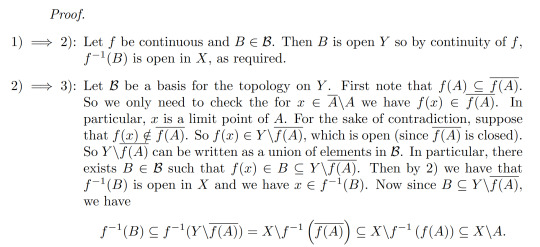

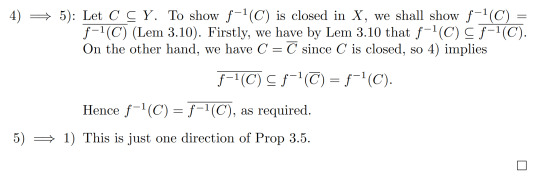
The next result give us another way to formulate the notion of a basis.
Theorem 8.4:




Lemma 8.5:



From the first and last of these results, we see sometimes need only check properties hold for the basis sets to conclude that the property is true for all open sets. This can help simplify proofs since often working with a basis narrows the types of sets you need to work with. We'll see an example of this in the proof that [0,1] is compact.
8.2: Second Countibility
Definition 8.6:

Recall: A set is countable if there exists an injective map from S to the natural numbers.
Before we see the next example, it is important to note that I will not show that ℚⁿ is dense in ℝⁿ as this is a typical result from a real analysis course. For those who aren't familiar with what density is, it just means that between any two real numbers, we can always find a rational number.
Example 8.7:

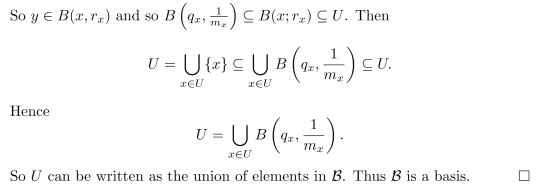
Remark: The fact that ℚⁿ is a countably dense subset of ℝⁿ is what allows us to do this proof. in fact, one can show that for metric spaces having a countably dense subset (this is called a separable space) is equivalent to second countability. In general this is not this case, although second countability does imply separability.
Now we shall see that second countability is yet another homeomorphism invariant!
Lemma 8.8:
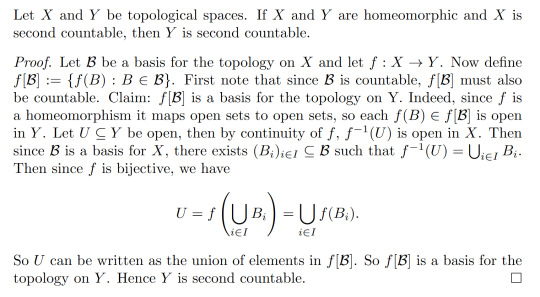
As far as I've planned, this is the last post dedicated to finding "useful" properties that topological spaces can have. There are certainly many more but the ones that we've covered are what is typically covered by a course in Topology.
The next post will be about product spaces which is one way we can construct new topological spaces out of old ones. The construction makes direct use of what we've done in the post as we will define the product topology by giving a basis of it!
P.S: Separability isn't typically mentioned in a first course but I learnt about it in my analysis module and thought it was an interesting property. We wouldn't actually need to do much more work to introduce both the notions of density and separability and to show that separability is a homeomorphism invariant. So I might make another post about it after this series has finished.
13 notes
·
View notes
Text
The labor movement is a capricious friend — it hands out heartbreak as much as it hands out joy. But every once in a while, it is able to wave a triumphant flag and give us all a glimmer of what its potential could truly be.
The recently concluded UAW strike offered just such a moment. It wasn’t just the contract agreements themselves, which were a material success, but also the union’s public call for movement-wide coordination to build the possibility of mass action around the May 1, 2028 expiration of the next auto contracts. “We invite unions around the country to align your contract expirations with our own so that together we can begin to flex our collective muscles,” the UAW declared on October 29.
This could be the beginning of the most exciting resurgence of American organized labor power in a century. Or, it could just be a tweet. What happens in the coming months will determine which of those things is the case.
The general feeling of a labor power resurgence since the pandemic has been fueled by a procession of high profile wins: The Starbucks and Amazon union drives, the massive organizing on college campuses, the friendly Biden administration and its uniquely pro-union NLRB, the historically high favorability of unions in public opinion polls, the periodic mini-strike waves at a variety of fed-up workplaces. This year, we have seen a trio of actions — the Teamsters backing down UPS with a credible strike threat, and the successful WGA and UAW strikes — that show what can be won with the power of strikes at a larger scale.
All of this is encouraging. All of this is evidence of a real shift in public sentiment. All of this, however, does not add up to a robust and lasting change in the balance of power between capital and labor. Right now, what we have are a bunch of discrete occurrences, a bunch of data points that amount to proof of potential.
There are two things that will determine whether or not this promising moment leads to a true, historic revival of the labor movement. The first is easily measurable: union density. Barely one in ten American workers is a union member today. Despite all of the wins just mentioned, that number has not risen in the wake of the pandemic. The primary thing that unions need to do today is to organize more union members. Without this, organized labor is a walled and shrinking garden, rather than a legitimately expansive force for society-wide change.
The second thing is related to the first, but it offers a broader menu for action: We must see some tangible coordination of action across the U.S. labor movement. It is great when one union wins a contract, or organizes an important new company, but those isolated events will not be enough to take on the combined power of trillion-dollar multinational corporations and their political allies. Not even when they involve tens or hundreds of thousands of workers. Big unions, the ones with the most resources, along with whatever non-union groups want to help them, must be able to sit down and plan and carry out big national campaigns together if we want to have any chance at winning the class war.
Amazon will never be a unionized company without an enormous, multi-union campaign. Nor will the powerful and wealthy tech industry be organized without an enormous multi-union campaign. We will never achieve the eternal goal of “organizing the South” without an enormous multi-union campaign. Nor will we ever pull off strategic general strikes without an enormous multi-union campaign.
The process of scaling up from some unions making incremental progress to a national labor movement strategically building and exercising labor power wherever and whenever it needs to, all in order to drown the monster of inequality once and for all, will require a whole lot of coordination. That sort of coordination — the sort that happens in service of movement goals, rather than those of individual (and sometimes feuding) unions — really doesn’t happen today.
Ideally, an organization like the AFL-CIO would have begun coordinating such an effort years ago. But they haven’t, and there is little evidence that they will. So unions will have to build these coalitions themselves. And that’s what made the UAW’s public call for other unions to line up their contract expiration dates with theirs so exciting.
This is not some meaningless fringe group. This is a powerful, national union with more than 400,000 active members, fresh off winning a consequential industrial strike, that is shining the Labor Movement Bat Signal high in the sky and beseeching its peers: Join us! If we get ourselves aligned, in four and a half years, we can really put the capitalists in a headlock.
There is much to love about this strategy. It is both powerful and achievable. Lining up contract dates does not require the blood, sweat, and uncertainty of huge new organizing campaigns. It is a way to make existing unions stronger by drawing their influence together into a single point. (Look at the Culinary Union in Las Vegas, currently threatening to strike the entire Las Vegas strip, for an example of what can be won with this tactic in practice.)
Doing this not just in one union or one industry but across many unions in many industries can set the stage for a mass walkout. It can make political power brokers pay attention in ways that they otherwise wouldn’t. It can captivate the public, and draw them into the fight even if they are not union members. It is a real world example of scaling up. It is not just one group of unionized workers making a demand for themselves; it offers the promise of workers in general making demands for the entire working class, backed up by the threat of a general strike. It’s not a dream. It can be done. The UAW is exactly the sort of credible organization that can be the launching point.
Realistically, the UAW and its allies need to convince many of their fellow big unions that this is a real goal within the next six months.
What it will take is other major unions taking this call seriously. Most union contracts are three years long, give or take. That means that unions must begin planning for this now. Contracts that are negotiated in 2024 and 2025 need to set their expiration dates for May 1, 2028. Realistically, the UAW and its allies need to convince many of their fellow big unions that this is a real goal within the next six months. There should be furious inter-union lobbying already taking place. The more radical unions, who have an actual vision, should publicly sign onto this plan in the near future, and then they should fan out and try to draw in the less radical unions, by arguing that this action is low-risk common sense. It’s a good argument!
The bigger this gets, the stronger it is, and the more it helps every union. And the more it helps every union, the more leverage it gives this broader coalition of unions to make larger demands that will benefit everyone in the working class, unionized or not. Union leaders need to be made to see the virtues of this argument soon. The case then needs to be made to individual units, and to individual workers, who will have to decide that they want their own contracts to be a part of this strategy.
There is not a lot of time to waste. But on a more positive note, this is a uniquely plausible opportunity for a historic boost in organized labor power. The path to achieving this goal is very straightforward, and there is no part of it that is not within the capabilities of existing unions, their organizing staff and current members. It does not require finding a huge amount of new resources. It just requires today’s unions to have a little vision, and to be willing to work together.
Sometimes, ironically, those qualities are in short supply in the labor movement. But there is no reason we can’t stop being our own worst enemy, right now. Big things are on the table. Let’s reach out and take them.
20 notes
·
View notes
Photo

Population density of Belgium, 2022.
The population density is one of the highest in Europe at about 377 people per square kilometer in 2022. Brussels, the capital of the country and the seat of the European Union stands out
by milos_agathon
62 notes
·
View notes
Text
Pleiadian Starseeds

Starseed's are advanced hybrid human beings that originate as a celestial light source of consciousness from star systems outside of our solar sun, representing the expansional extraterrestrial hosted platforms of their consciousness, and capacities to hold greater missions on Earth not defined by human limitations.
It's important to note that you can tune into any Starseed origin. If you relate more to an origin that's not in your chart you can still hone the energy of this origin. The origins found in your chart are related to your upmost spiritual mission in this incarnation and depending on where they are located that origin will be your most supreme mission and guiding light force within the particular sign/house/planet.
Pleiades is made up of seven hot b-type stars. Very luminous, blue-open star clusters with beautiful reflection nebula's. This origin is influenced by the love and unity of The Virgin Companions of Artemis: The Seven Sisters, The Seven Doves, The Seven Cows, and The Seven Hathor's in Egyptian Mythology.
*The Mission of The Pleiadians*
A Pleiadean alignment in your natal chart would represent the compassionate divine union of the spirit within your being as your primary mythology to the planet. Your mission being deeply committed to being the spiritual healers of Earth.
Many indigo children incarnated from Pleiades. Specifically those born during 1998 to 2008; belonging to the Omega Generation. This is the last "pure" indigo generation. These people are hybrids of indigo/crystal children and are referred to as "the flame throwers" - mainly incarnating under fire signs: Aries, Leo, Sagittarius. This generation seeks justice and oneness for all; upset with how the previous generations left the world.
Mostly represented under the zodiac sign Leo. Leo is the zodiac represented by Archangel Michael; although it is Aries/Taurus that runs along the Pleiades degrees, and Aldebaran/The Blue Rays/The Family of Michael run along the Taurus degrees. This energy is still honed through the zodiac sign Leo alone. Being the utmost representation of The Family of Michael. Pleiadeans also use The Lion's Gate Portal to incarnate. The true dates of this portal range anywhere from late Cancer to early Leo degrees. This is why many true Pleiadean origins have a cluster chart of Cancer/Leo, but there is usually a direct Pleiadean alignment through Aries/Taurus elsewhere in the natal chart. This doesn't have to be the case. You can be of true Pleiadean origin just through the Aries/Taurus degree markers with no Cancer/Leo placements present.
Through your Pleiadian origin you will experience a profound ascended state of the 5th dimension; bringing forth revelations of purification with the power to burn, the ability to transform, and the power to sustain life. These are the stars of fire, the stars of spirit, the stars of creation.
The most empathic and compassionate Starseed origin. Drawn to humanitarian efforts, nurturing, healing, spiritual guidance, and assisting other souls in their ascension process.
Powerful energy workers, highly psychic, intuitive, and sensitive. This origin is that of the spirit guides that assist with the spiritual evolution on the planet the most.
Pleiadians rule the heart chakra and are the ones that are the most concerned with unconditional love and unity.
This origin is the most affected by the astrological transitions of the moon; along with Sirius and Hydra origins. These origins fully embody the energy of the moon and are constantly in tune with her.
Most Pleiadian's are incarnating from the stargate Alcyone - the heart of Pleiades that holds the 4th/6th density/dimensional future parallel prototype of our Earth called Tara.
Those who have this origin alignment in their natal chart hold the gateway to the higher harmonic universe of our planetary existence and history of its evolution.
The Pleiadian's are a council within the Guardian Alliance that represent specific grid points on the planet that activate within its celestial alignment.
Pleiadian's were the most influential in the 2nd seeding of Lemuria. Many of this origin are deeply connected to Lyra. Even if a Lyra origin alignment is not present in the natal chart.
Many cultures and Galactic Civilizations believe that Pleiades is the true birthplace of the souls of the star people.
Pleiadians hold a profound connection to Archangel Michael and many will feel as if they are direct descendants and part of The Family of Michael (Aldebaran/The Blue Rays) even if there is no direct alignment with Aldebaran in the natal chart. This energy can be honed through Pleiadian origins alone.
Those with a direct/fixed Pleiadian origin alignment will have Aries and/or Taurus placements in their chart. Aries carrying the spiritual warrior energy of Pleiades and Taurus carrying the energy of unconditional love and unity.
Indigo children incarnated from Pleiades are usually born under fire signs: Aries, Leo, Sagittarius (as mentioned above.) With the majority being born under Cancer/Leo suns as they use The Lions Gate portal to incarnate. High degrees of Aries will be of Pleiadian origin, Leo origins are aligned to the Regulus Starseed origin (The Family of Archangel Raphael.) Sagittarius is linked to Shaula, Lyra, and The Sagittarius A Incarnates which make up the Lyran council.
Indigo Angel's Book: https://www.lulu.com/shop/indigoangel-amanda-jane-demarco/how-to-read-celestial-akashic-starseed-origins-lunar-edition/paperback/product-1qkdn6jj.html?page=1&pageSize=4
My Starseed Origin Tumblr: https://www.tumblr.com/blog/starseedoriginreadings
For business inquiries and Starseed origin readings please email [email protected] ! I accept paypal/venmo and do not require payment until after the reading.
*Starseed Origin Chart Readings*
Planetary Starseed Origin Reading: for $27 you will receive a list of each Starseed origin that is found within your astrological planets (along with any alignments found within your North/South Node, Lilith, Chiron, ASC, Midheaven, Fortune, Vertex, ect.) . You will also receive a full detailed description of where each Starseed origin is located at in your natal chart and what this means for you; along with a detailed description of the meaning behind each origin. For this reading it is required that you provide your exact time, date of birth, and location. I will use this information and provide you with your alignments based on both your Sidereal/Vedic and Western/Tropical Astrology charts.
Twin Flame Starseed Origin Reading: for $47 you will receive a list of each Starseed origin that is found in both you and your twin flame/counterparts astrological chart (along with any alignments found within your North/South Node, Lilith, Chiron, ASC, Midheaven, Fortune, Vertex, ect.) You will receive a full detailed description of where each origin is aligned in both you and your counterpart's chart; along with a detailed description of the meaning behind each origin and what it means for the both of you. For this reading it is required that you provide you and your counterpart's exact time, date of birth, and location. I will use this information and provide you with your alignments based on both you and your counterpart's Sidereal/Vedic and Western/Tropical Astrology charts.
Planetary Degree and House Starseed Origin Reading: for $27 you will receive a list of each Starseed origin that is found in your astrological chart along with a detailed description of the meaning behind each origin. This reading will tell you what Starseed origin your planets are connected to through house/degree placements. (Ex: having Mars in Cancer to the 29 degree means that your Mars is in alignment with Hydra. Having Mars in Cancer to the 29 degree while also having Mars in 12th house means that Mars is now overlapping the Andromeda Starseed origin as the Andromeda Galaxy is connected to the 12th house and runs along 29 degree Aquarius before moving into Pisces. Meaning that since Mars is positioned in the 12th house while also being in 29 degree Cancer, Mars is in alignment with both Hydra and Andromeda.) For this reading it is also required that you provide your exact time, date of birth, and location. I will use this information and provide you with your alignments based on your Western/Tropical astrological chart unless the reader requests otherwise.
Full Starseed Origin Chart Reading: for $47 this is a combination of the Planetary Origin Reading, and the Planetary Degree/House Reading. All information listed above for both readings will be included in this one. This reading does not include the Twin Flame Starseed Origin Reading. For this reading it is also required that you provide your exact time, date of birth, and location. I will use this information and provide you with your alignments based on both your Sidereal/Vedic and Western/Tropical Astrology charts.
#pleiadianstarseed#pleiades#pleiadian#starseed#starseeds#stargate#spiritualawakening#higherconsciousness#astro notes#astrology chart#astro community#astro observations#astro tumblr#birth chart reading#chart readings#lions gate#leo#cancer#archangel michael#spiritual healing#energy work#spiritual journey
85 notes
·
View notes
Text
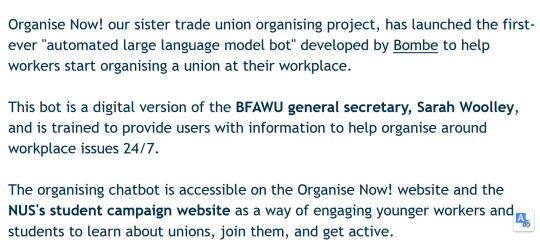
Cackling at the concept of this campaign setting up a Robo Trade Union Leader to solve the problem of low union density
8 notes
·
View notes
Text
While these protests succeeded in disrupting normal operations at the targeted arms companies, they were unable to meaningfully halt the manufacture of weapons, in part because the group best poised to shut down production was conspicuously absent from each of the actions: the companies’ workers. More than two million US workers are employed by the weapons industry, which produces over 80% of all of Israel’s arms imports, including “precision guided munitions, small diameter bombs, artillery, ammunition, Iron Dome interceptors and other critical equipment,” according to the Pentagon, as well as F-35 aircraft—the most advanced fighter jets in the world. In the past month and a half, Israel has used these weapons in a genocidal assault that has killed more than 14,000 Palestinian civilians in Gaza, at least 5,600 of them children. The violence has prompted direct action against the Israeli war machine’s supply chain, with protesters targeting not only munitions factories but also ships transporting arms to Israel and financial firms with significant investments in the weapons industry. But unlike in many other parts of the world, where weapons workers have led the disruption in response to an urgent call for solidarity from Palestinian trade unions, in the US, unions in the weapons industry have so far remained outside the fray.
This is despite the presence of tens of thousands, if not hundreds of thousands, of unionized workers in the US weapons industry, some of whom are employed at the very factories that protesters have attempted to shut down this fall. As journalist Taylor Barnes reported earlier this year, each of the five major Pentagon contractors—Lockheed Martin, Boeing, Northrop Grumman, Raytheon, and General Dynamics—employs some unionized workers, although union density at the firms ranges from as low as 4% at Northrop Grumman to as high as 32% at Boeing. Many of these unionized workers belong either to the International Association of Machinists (IAM), or to the United Auto Workers (UAW), which is part of a renaissance in the US labor movement. Both unions include employees at Boeing, Lockheed Martin, Raytheon, and General Dynamics; the IAM additionally represents workers at Northrop Grumman and M7 Aerospace, a wholly owned subsidiary of the infamous Elbit Systems, while the UAW represents workers at Woodward, Inc., an aerospace firm that gained unwanted attention last month after a viral photo from the ruins of Gaza appeared to show a used missile component with the company’s logo on it. The unions are also actively organizing more workers in the weapons industry: Just last month, for example, the IAM unionized 332 Lockheed employees in Kentucky.
For anti-war labor organizers in the United States, unionized weapons workers present a paradox: Serving such members ostensibly requires making weapons industry jobs stable and remunerative, but the principles of global solidarity call for dismantling the war machine altogether. Traditionally, US unions have only pursued the former mandate. As one anonymous local union president in the industry put it to researcher Karen Bell earlier this year, “my top priority is trying to make sure that we have work in jobs in the United States . . . I don’t make a lot of judgments on anything other than, what can you do to keep the people I represent in work? That’s my job, and to be anything other than that, it would really be a disservice to the people that are paying my salary.” Rather than questioning their role in the industry, unions have reconfirmed their relationships with weapons companies since the start of Israel’s assault on Gaza. Last month, 1,000 IAM members in Arizona and 1,100 UAW members across the Midwest separately ratified new contracts with Raytheon and General Dynamics respectively, during a period when both companies were actively implicated in the mass killing of Palestinian civilians. When the Raytheon contract deal was announced on October 22nd, one IAM leader said he was “proud to support our Raytheon members and excited for this contract’s positive impact on their lives”—a statement that highlights the seemingly irreconcilable conflict between the economic interests of weapons industry workers and the anti-war, anti-genocide movement.
#solidarity w h e n c e#you should read the whole article there's a lot more discussion of history/suggestions for the future#but also god the shortsighted selfishness of usamericans is fucking dire#the 'left' is this country is doomed to have its political hopes relentlessly thrashed to a bloody pulp as long as it is this spineless#yeah we live in a hellworld w v real obstacles against us but also capitalism and imperialism are systems unbound by borders#and neither should your organizing be bound! hang together or hang separately you absolute fools#IMPERIAL VIOLENCE ALWAYS COMES HOME#if you need a reasons that aren't. morals.#anyway. that's my thankless cassandra prophecy for the day.#military industrial complex#labor rights#palestine#news#my posts#no more war
16 notes
·
View notes
Text
3. "Try not to shit yourself Gary. It's just an open door."
GARY, THE CRYPTOFASCIST - "What could it be about?" He frets to himself, not taking your advice. "I probably talked too loud. In the Whirling. About some theories I had. Whatever it is, I'm done with it."
"I won't do it again." He looks around nervously. "If there's anything I can do to assist you -- or the Union -- just ask, okay? I'll try to help if I can."
+5 XP
HALF LIGHT [Easy: Success] - This scared him proper. He's positively *melting* from fear. Has to prop himself up with a lot of anger to keep it together.
KIM KITSURAGI - "The weather vane has turned," the lieutenant remarks with a smirk. "He cannot be un-turned."
EMPATHY [Trivial: Success] - He clearly liked his squirming. He may even have changed his mind about the whole door-opening operation.
+1 Reputation
4. "Thank you for your cooperation." [Leave.]
We're going to look for Morell's traps while we keep exploring the coastal area.
🎵 Disco Elysium

No boat in the boat house today.
Snow's really starting to pick up.
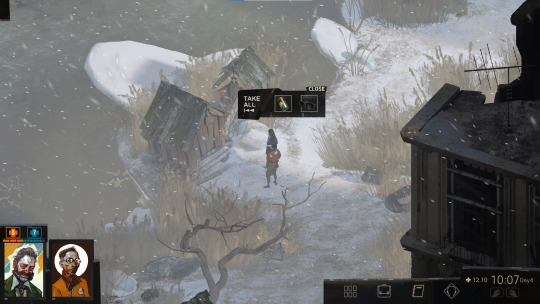

OVERSIZED SUPERSTAR SUNGLASSES
+1 Savoir Faire: Dazzling reflexes
-1 Visual Calculus: The mirror lies
Is your own stardom too dazzling for your eyes? Can't bear to look at your own fabulous reflection in the mirror? Then these classic oversized sunglasses are for you.

TRAP: BOATHOUSES - There's a trap in the reeds at your feet. Looks like the same one you saw Morell set before -- same mesh, same wiring.
Look around.
Reach for the trap.
[Leave.]
TRAP: BOATHOUSES - Behind you, the ruins of a residential building loom over the reeds. They whisper amongst themselves confidentially. Snowflakes cling to their shivering stems.
SHIVERS [Medium: Success] - When this district was booming, the reeds were kept at bay. Nothing obscured the freshly painted façades, nowhere for drunks and adventurous teenagers to hide. Now only the wind blows...
2. Reach for the trap.
TRAP: BOATHOUSES - Locusts are crawling around in the trap, confused but uneaten. You see no carnivorous *reed-phasmid* gorging on them.
KIM KITSURAGI - "Big surprise." The lieutenant grins mirthlessly. "Anyway -- one down, three to go."
"Damn, I was hoping it would be in the *first* one."
"No need to grin. I'm not *expecting* to find anything. I'm helping some citizens and getting some fresh air."
"It'll be in the next one. *Surely*."
Say nothing, just put the trap down.
KIM KITSURAGI - "Surely," he repeats and looks at the sea, then at you putting the trap back on the ground. "Anyway, the air is nice and fresh here..."
2. [Leave.]
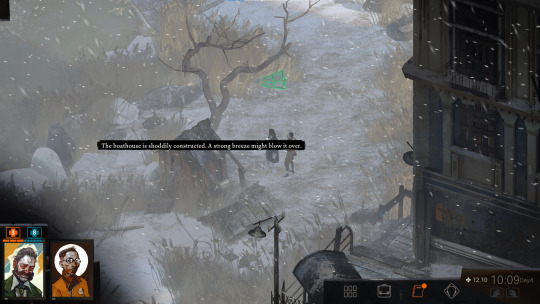
The boathouse is shoddily constructed. A strong breeze might blow it over.

Ancient paint is peeling off the roof of this shaded bench, covered in rust.

The sign says: "Entrée interdite".

An old ticket-taker booth. No longer in operation.
People paid money to park here? No one would pay now...

The door is not only barred shut -- it is inaccessible.


FALN "PIPO" PIPO
+2 Logic: Ultimate peak focus
-1 Perception: Eyes on the road
The small wire framing inside this futuristic-looking FALN pipo-hat gives it the aerodynamic shape of a swoop-skiers helmet, but none of its protective qualities. Covers the wearer's ears and eyebrows to bring down the drag coefficient.
🎵 Martinaise, Terminal B (muted)

PERCEPTION (SIGHT) - A scattering of bullet holes is spread across the cracked wall, reaching from one corner to the other.
"Look, Kim. Even more bullet holes. Something's definitely gone down here."
[Visual Calculus - Heroic 15] Why this many bullet holes?
Walk away. [Leave.]
KIM KITSURAGI - "Hmm, correct." The lieutenant examines the wall closely. "The density of the bullet holes is unusual, even in a general *average bullet hole frequency in Martinaise* sense. Grim affairs."
"Meaning, this is *a lot* of bullet holes." He brushes the wall with his hand. "Looks like fully-automatic rifle fire. Something you don't see these days..."
"Why not?"
Say nothing, just nod.
KIM KITSURAGI - The lieutenant also nods. It is quite a scene -- the two of you standing next to the broken wall of an abandoned building... nodding. Nodding along.
ESPRIT DE CORPS [Medium: Success] - Two officers of the law against the world. Nodding in unison. It is your source of power. The bond of camaraderie between you... is palpable...
Nod even more.
Shake your head.
KIM KITSURAGI - The lieutenant is nodding so hard it looks like his head is about to snap off his neck.
Don't stop nodding.
Stop nodding.
KIM KITSURAGI - The lieutenant matches your nodding pace. He's a true professional at this.
ENDURANCE [Easy: Success] - The nodding's reaching critical mass! You can't take this much longer, captain!
Keep nodding, goddamn it! Stay the course!
Stop nodding.
KIM KITSURAGI - A small bead of sweat runs down the side of the lieutenant's face as he maintains his nodding...
Just one more nod.
Stop nodding.
KIM KITSURAGI - As the lieutenant takes out a handkerchief and softly taps the sweat off his temple... a faint crack echoes through the coast...
ENDURANCE - Abort! Abort! No... shit, it's too late!
-1 Health
"OH SHIT FUCK HELL!"
KIM KITSURAGI - "Busted the neck, did you?" He cranes his neck left and right, stretching. "Glad I stopped when I did... my neck was really starting to hurt. Don't worry, it'll mend... now, we should get going."
Hold on...

2. [Visual Calculus - Heroic 15] Why this many bullet holes?
+1 Bullet holes on the plaza.
+1 Bullet holes in the back yard.
+1 Know about the revolution.
+1 Know about Feld Electrical.

VISUAL CALCULUS [Heroic: Success] - A row of ghostly shades stand facing the wall. There are many of them, a dozen at least, their heads lowered and eyes blindfolded. It's quiet. No sound, no movement.

Ten metres away -- other shades are lined up in an orderly manner, automatic rifles primed. A gust of wind blows by -- the coats of the firing squad flap slowly in the breeze. A single person stands on the side.

The morning sun rises beyond the horizon, radiating the first light of the day. The order was carried out at dawn.
A long time has passed since the moment of this fusillading. Rain and brine have since washed all the blood away. Not a trace remains.
What *is* this...
VISUAL CALCULUS - The abundance of bullet holes leads to two options: either an inordinate amount of executions were performed here, or they did not use a *conscience round* -- where only one soldier has the loaded rifle. Looks like this was a mass execution with everyone fully armed.
+5 XP
Look at the people against the wall.
Look at the line of soldiers.
Look at the person standing on the side.
"Kim, who was who in this execution?"
Good bye. [Leave.]
VISUAL CALCULUS - A host of men, probably in everyday clothes -- ragged from the conflict and covered in dust. They were not sitting (a common practice for executions in some nations), as demonstrated by the height level of the bullet holes.
They stand, facing the wall... It's impossible to discern any details about their personality or background.
ESPRIT DE CORPS [Easy: Success] - Ordinary people -- familiar, each and every one of them.
Who were they?
ESPRIT DE CORPS - Comrades. The forsaken, the wretched, who tried to rise against the horrors of the world.
2. Look at the line of soldiers.
VISUAL CALCULUS - Seven men in combat uniforms and dark coats, holding automatic rifles aimed at the people. Soldiers from some side... but from which one?
AUTHORITY [Medium: Success] - Men of duty. Dark duty.
Who were they?
AUTHORITY - Murderers. Twisted by orders. Young boys forced into killing.
3. Look at the person standing on the side.
VISUAL CALCULUS - The commandant -- the one who gives the order. Machine gun fire crackling through the air, the lights of the muzzle flashes dancing on his face...
4. "Kim, who was who in this execution?"
KIM KITSURAGI - At first the lieutenant doesn't say a word... he just stares at the wall. "I don't know," he says finally. "I don't know who died here, lined up beside that horrible wall. It could have been any of the parties involved in the Revolution."
"Perhaps the ones executed here were the loyalist-conservatives -- killed by the communists at the start of the civil war. Or it could have been the communists, put to death during the last stretch of the conflict by the Coalition forces."
LOGIC [Easy: Success] - Remember what Trant Heidelstam said about Feld.
"What if it was the Feld personnel when their assets were being seized by the revolutionaries?"
KIM KITSURAGI - "Another likely scenario." The lieutenant nods.
REACTION SPEED [Easy: Success] - Or maybe...
"What about people from the Coalition? The so-called moralists?"
KIM KITSURAGI - "Yeah... it's very unlikely the Coalition forces were the ones who died here. They were always the *last* ones against the wall."
"To be honest, if a Coalition member was anyone in this situation -- it was the commandant. The superior giving the orders."
+5 XP
5. Good bye. [Leave.]
VISUAL CALCULUS - A cold sea wind blows away the figures.
🎵 Disco Elysium
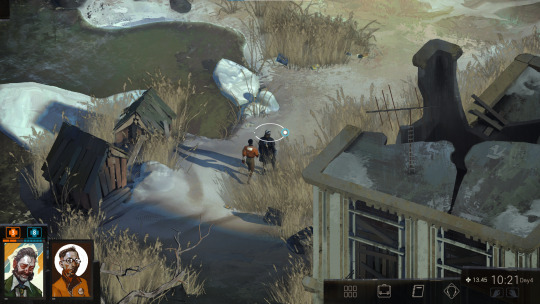
This section of the coast hasn't been used in decades.
We've been looking at that wall long enough for Gary and Morell to have left.

TRAP: MORELL - This is the trap Morell just set. Checking it over, he said, is just a *technicality*, but...
Look around.
Reach for the trap.
[Leave.]
TRAP: MORELL - The reeds by the abandoned camp site hiss and shake.
SHIVERS [Easy: Success] - The later it gets, the colder. Remnants of the camp can still be seen in the sand, the fire that's gone out... you feel strange, somehow.
2. Reach for the trap.
TRAP: MORELL - This trap is also full of panicked locusts. No sign of any cryptozoological beast inside.
KIM KITSURAGI - "Another empty trap," the lieutenant takes a note -- more out of habit than duty.
"Let's keep going. The next one is the *lucky* one."
"How are you enjoying the cardio, lieutenant? I'm quite enjoying it myself."
"I want to make it clear that I don't *actually* believe the phasmid exists, okay?"
Say nothing, just put the trap down.
KIM KITSURAGI - "Always up for a good jog -- otherwise, would I still be *on* this case with *you*?" He smiles and raises his collar. It's windy.
2. [Leave.]
We're going to double back now, starting to head northeast along the boardwalk - past where Trant and his son are.

Someone must have worked hard to smash the plastic dome.

Buzz. Hum. The electricity flows through the wires with audible power.

RAILING - Someone has left an unidentifiable article of clothing on this railing. It smells really bad.
Touch it.
Take a closer look.
Maybe later. [Leave.]
RAILING - The cloth, if you can still call it that, makes a soft crunching sound as you thrust your finger into it.
2. Take a closer look.
RAILING - It's streaked with dried seagull shit and tangled with pieces of seaweed. A dangling arm suggests that there might be a jacket beneath the crust of filth.
LOGIC [Medium: Success] - It seems likely that it was left in the surf until someone laid it out on this fence to dry out. Unfortunately that just seems to have stiffened it into a shapeless mass.
KIM KITSURAGI - "Please tell me you're not taking that with you."
"I think this is the jacket the Idiot Doom Spiral Guy wanted me to find."
"Why not?"
"It might be a clue."
KIM KITSURAGI - "A clue? You think our suspect is a seagull who's been defecating on unsuspecting jackets?"
"No."
"Yes."
"It could have been multiple seagulls."
KIM KITSURAGI - The lieutenant sighs.
CONCEPTUALIZATION [Medium: Success] - A poet could write a dozen verses and still not begin to capture the profound vexation in that sigh.
INTERFACING [Trivial: Success] - You should still take it. It's probably Doom Spiral's.

A makeshift roof. Vagrants have tried to make the boardwalk habitable.
That tarp will keep out neither rain, nor snow, nor wind.
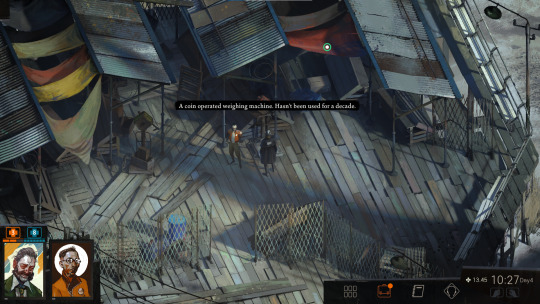
A coin operated weighing machine. Hasn't been used for a decade.


MEGA-BINO'S PRESCRIPTION LENSES
+2 Encyclopedia: Discover your inner bino
-1 Perception: Nausea inducing hell-glasses
Whose idiotic idea were square and beige plastic frames anyway? Beige is a colour that does not look good on *anyone*. Not to mention that seeing the world through these exceedingly thick lenses feels almost nauseating...
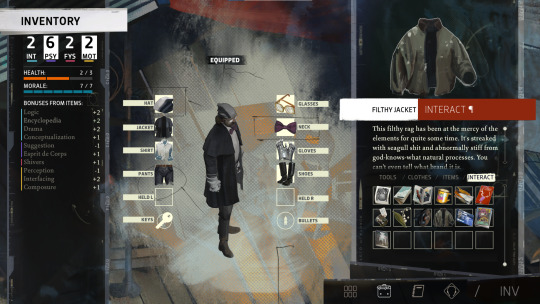
FILTHY JACKET
This filthy rag has been at the mercy of the elements for quite some time. It's streaked with seagull shit and abnormally stiff from god-knows-what natural processes. You can't even tell what brand it is.
>INTERACT
FILTHY JACKET- As you hold it in your hands, it makes an uncomfortable crunching sound...
Man, how did this jacket get so disgusting?
Let's not think about that right now. [Put the filthy jacket away.]
FILTHY JACKET- It's a sordid, filthy tale, not for the weak. Are you sure you can stomach it?
COMPOSURE [Medium: Success] - Some secrets are better left uncovered. Don't even try, seriously.
But the *content*!
Think about it.
Don't think about it.
FILTHY JACKET- It occurs to you that you're not even *holding* the jacket itself, but rather the thick crust of jetsam and seagull shit that ensconces it.
PERCEPTION (SMELL) [Medium: Success] - It smells like a dead sea creature, tangled in grey strands of seaweed. It must have spent quite some time in the water before the tide deposited it ashore...
Gross.
Okay, but what's the crust *made* of?
FILTHY JACKET- Somehow it was carried or dragged to the boardwalk, if not by human hands than perhaps the feral dogs that prowl the beaches at night...
VISUAL CALCULUS [Medium: Success] - The faint impressions of many footprints are also present, though it's impossible to tell what kind or how many. Suffice to say, the jacket spent some time on the ground before someone draped it over the railing...
Okay, that's pretty disgusting. I've had enough.
What happened once someone put it on the railing?
FILTHY JACKET- The crust is hard. This jacket spent at least a day baking in the sun. Who knows what happened to it then?
SHIVERS [Medium: Success] - Somewhere, high above the city, a pair of seagulls trace loops through the air...
They are like the bombardiers of the aerostatic brigades, gliding above a *target-rich environment*...
All of a sudden, the bomb bay doors open, and their white glittering payload rushes to the ground...
*SPLAT*. An explosion of white on a man's shoe. A curse goes up, but the birds do not hear.
Why did I just spend all this time thinking about seagull shit?
I feel like I really understand this jacket now. [Put the jacket away.]
COMPOSURE - It's too late! You've already thought about it. And now your hands are covered in muck!
Ew, ew, ew! (Flick your hands.)
Maybe if I wipe my hands on my pants?
COMPOSURE - Now you're just flicking that shit everywhere! This is a disaster. You'll never get the smell out.
-1 Morale
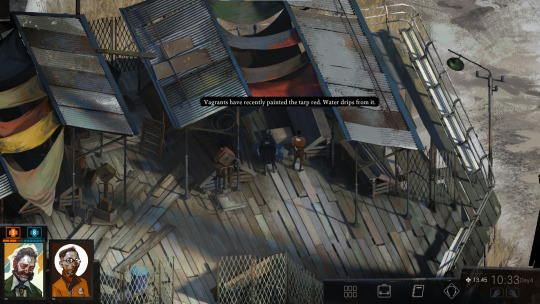
Vagrants have recently painted the tarp red. Water drips from it.


POSTCARD "COURON '33"
This one has 'HELL' written on its back. It could not be further from the truth. It's the boom years, and Couron, the nicest district in Revachol West, is enjoying a sun drenched day. Tall and handsome buildings rise from the riverside: steel, iron and yellow limestone, with cloud shadows sliding on the facades.
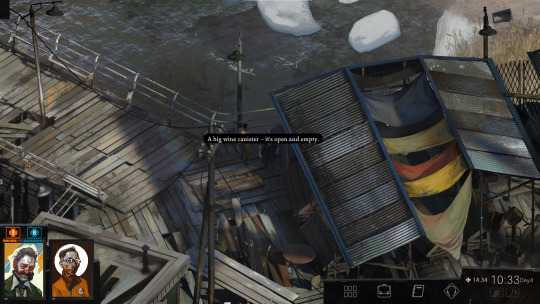
A big wine canister -- it's open and empty.
Hm, I've hit image limit. I think I'll close this post here and continue in a new one.
8 notes
·
View notes